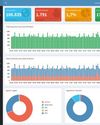
In the previous issue of Linux Magazine, I introduced the digital integrated circuits called field-programmable gate arrays (FPGAs) [1], explained why they are important, and described the bare minimum needed to set up and try a state-of-the-art FPGA design environment on Linux. This article, which is divided into three parts, concludes that introduction.
First I’ll describe the main types of elementary digital circuits that can be built, combining the logic gates covered in the first tutorial and the basic features of hardware description languages (HDLs) that allow their implementation and simulation.
The central part combines some HDL code that's freely available online [2] [3] into one simple HDL module and the code necessary to simulate it. The final part shows a run of that simulation and concludes by explaining why Linux is the perfect platform for working with FPGAs.
Representing Digital Circuits with HDL
FPGAs (and every other digital integrated circuit) comprise millions of logic gates, with boolean input and output signals – that is, having one of two states, conventionally represented as 1 or 0.
Sequential components are combinations of logic gates that sample all their input ports, and (with constant, predefined delays) update their outputs on the positive or negative fronts of one or more signals called clocks (i.e., square waves of a fixed frequency that constitute common timing references for the chip).
The simplest sequential block is a memory element, also called a flipflop [4], that can load and preserve binary values: Its output changes only on the fronts of a control signal, almost always a clock, copying and then preserving whatever value the input pin has in those instants.
This story is from the #272/July 2023: Open Data edition of Linux Magazine.
Start your 7-day Magzter GOLD free trial to access thousands of curated premium stories, and 8,500+ magazines and newspapers.
Already a subscriber ? Sign In
This story is from the #272/July 2023: Open Data edition of Linux Magazine.
Start your 7-day Magzter GOLD free trial to access thousands of curated premium stories, and 8,500+ magazines and newspapers.
Already a subscriber? Sign In

URL filtering with Pi-hole Into the Funnel
Supporting browser plug-ins, network-based DNS blockers like Pi-hole help protect you against online tracking and unwanted content.

Artificial intelligence on the Raspberry Pi Learning Experience
You don't need a powerful computer system to use Al. We show what it takes to benefit from Al on the Raspberry Pi and what tasks the small computer can handle.

MakerSpace Manage your greenhouse with a Raspberry Pi Pico W Sheltered Growth
You can safely assign some greenhouse tasks to a Raspberry Pi Pico W, such as controlling ventilation, automating a heater, and opening and closing windows.

Control Center
Tipi gives you complete control of more than 100 applications and services. A mouse click is all it takes to install the apps.

In One Fell Swoop
Topgrade detects all the package managers installed on a system and executes them one by one at the command line.

Go Faster!
The fastest way through a curve on a racetrack is along the racing line. Instead of heading for Indianapolis, Mike Schilli trains his reflexes with a desktop application written in Go, just to be on the safe side.

Math Magic
MathLex lets you easily transform handwritten math formulas to digital format and use them on the web.

Custom Repair Toolkit
You can do more with System Rescue than just repair broken systems. By adding tools and scripts, you can create a custom rescue environment that meets your needs.

At Your Disposal
Debvm lets you quickly create a temporary virtual machine with a small memory footprint, ideal for testing scripts or mixing repositories

A Fresh Breeze
Vanilla OS, an immutable filesystem, seamlessly integrates applications from other distributions with an innovative container-based package manager.